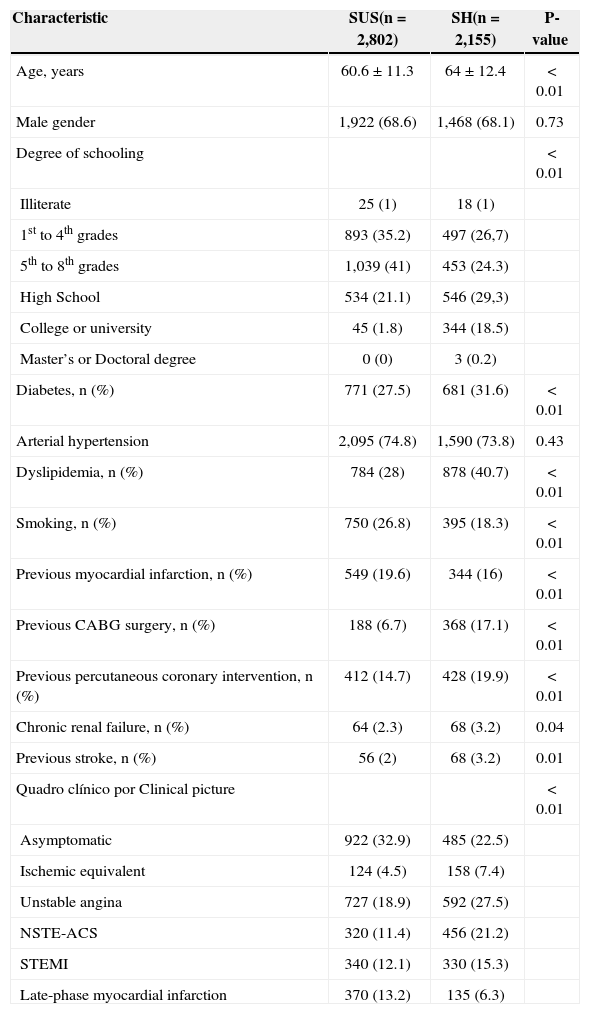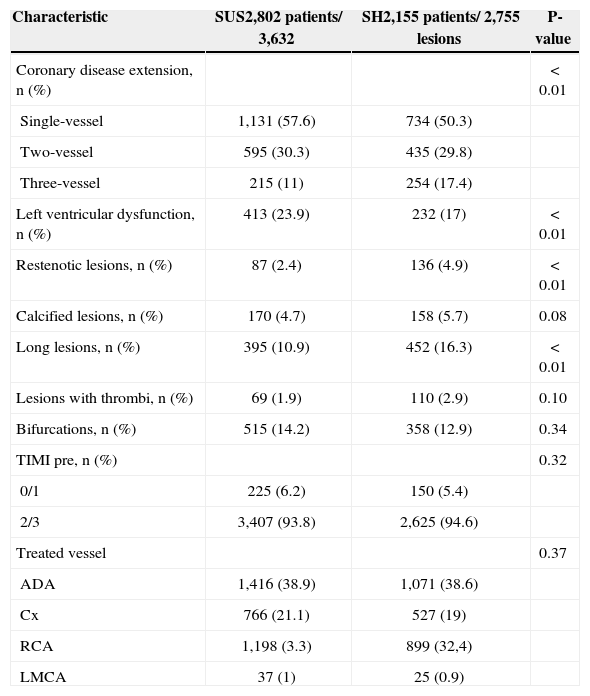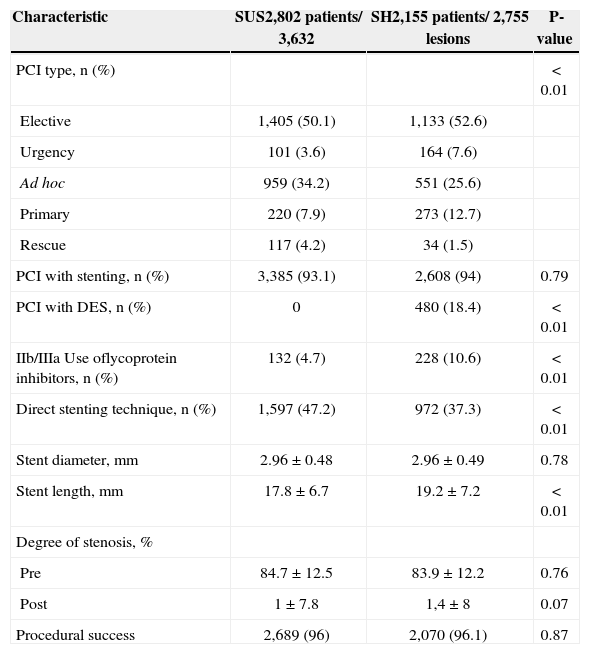The main healthcare funding systems in Brazil, the public and the private healthcare systems (PuHS and PrHS, respectively), have peculiar characteristics and cover almost all patients referred for percutaneous coronary intervention (PCI). Our objective was to identify population differences and PCI hospital outcomes in patients using both systems.
MethodsFrom August 2006 to November 2010, 4,957 consecutive patients were submitted to PCI, 2,802 (56.5%) were from the PuHS and 2,155 from the PrHS.
ResultsPatients from the PuHS were younger, had less education, greater incidence of smoking, prior myocardial infarction (MI), single-vessel disease, left ventricular dysfunction, and received more direct stenting. In the PrHS group, there was more diabetes, dyslipidemia, prior coronary bypass graft surgery (CABG) and PCI, prior stroke, chronic renal failure, ST-segment elevation and non-ST segment elevation acute coronary syndromes, restenotic lesions, long lesions, primary PCIs, use of glycoprotein IIb/IIIa inhibitors and drug-eluting stents. PCI success (96% vs. 96,1%; P=0.87), MI (1.7% vs. 1.8%; P=0.72), CABG (0.1% vs. 0.2%; P=0.85), stroke (0.1% vs. 0.1%; P>0.99) and death (1% vs. 1.2%; P=0.48) were not different between groups.
ConclusionsPatients from the PrHS had greater clinical and angiographic complexity than those from the PuHS. However, these differences did not affect the success of the procedure and the rate of in-hospital major adverse cardiovascular and cerebrovascular events.
Resultados da Intervenção Coronária Percutânea de PacientesTratados pelo Sistema Único de Saúde e pela Saúde Suplementar
IntroduçãoOs principais sistemas de custeio da saúde no Brasil, o Sistema Único de Saúde (SUS) e a saúde suplementar (SS), têm características peculiares e abrangem a quase totalidade dos pacientes encaminhados para intervenção coronária percutânea (ICP). Buscamos saber as diferenças populacionais e os resultados hospitalares da ICP entre os pacientes desses dois sistemas.
MétodosNo período de agosto de 2006 a novembro de 2010, 4.957 pacientes consecutivos foram submetidos a ICP, 2.802 (56,5%) pertencentes ao SUS e 2.155 à SS.
ResultadosPacientes do SUS eram mais jovens, com menor grau de escolaridade, maior ocorrência de tabagismo, infarto do miocárdio (IM) prévio, lesões em um único vaso, disfunção ventricular esquerda, e utilização da técnica de stent direto. No grupo SS ocorreram mais diabetes, dislipidemia, revascularizações percutânea e cirúrgica prévias, acidente vascular cerebral prévio, insuficiência renal crônica, síndromes coronárias agudas, com e sem supradesnivelamento do segmento ST, lesões reestenóticas, lesões longas, ICPs primárias, e uso de inibidores da glicoproteína IIb/IIIa e de stents farmacológicos. Sucesso da ICP (96% vs. 96,1%; P=0,87), IM (1,7% vs. 1,8%; P=0,72), cirurgia de revascularização (0,1% vs. 0,2%; P=0,85), acidente vascular cerebral (0,1% vs. 0,1%; P>0,99) e óbito (1% vs. 1,2%; P=0,48) hospitalares não diferiram entre os grupos.
ConclusõesOs pacientes da SS apresentaram-se com maior complexidade clínica e angiográfica que os do SUS. No entanto, essas diferenças não alteraram o sucesso do procedimento e os eventos cardiovasculares e cerebrovasculares adversos maiores hospitalares.
Coronary artery disease is a major cause of morbidity and mortality in Brazil, and is responsible for high costs in both the Unified Health System (Sistema Unico de Saude – SUS), which relies on public funding, as well as the supplemental health (SH) system, which utilizes private funding. In 2010, 55,754 percutaneous coronary interventions (PCIs) were performed in SUS patients, which cost over R$ 85 million.1
These two healthcare systems have specific characteristics and cover almost all patients referred for PCI. The public health system, SUS, in spite of its concept of universality, does not make drug-eluting stents available, the device of choice in PCIs performed in developed countries. SUS also limits the use of stents to, at most, two devices per procedure, which makes the percutaneous treatment of coronary artery disease more complex, generating staged interventions or referrals for coronary artery bypass graft (CABG) surgery, which are associated with higher costs.2 The SH system does not have these limitations; however, there is an increasing demand from health plan agencies for medical justifications for the interventions and for the materials needed.
The aim of this study was to assess the impact of these differences on the in-hospital PCI outcomes in an institution that provides care to patients who belong to either of the two healthcare systems available in Brazil.
METHODSPatientsFrom August 2006 to November 2010, 4,957 consecutive patients underwent PCI at the Interventional Cardiology Department at the Hospital Bandeirantes (São Paulo, SP). Among these, 2,802 (56.5%) were SUS patients and 2,155 were SH patients, constituting the two groups compared in this study. Clinical, angiographic and procedural characteristics were compared, as well as the success rates and incidence of adverse events until hospital discharge.
The data were prospectively collected and stored in a computer database for future analysis.
Percutaneous coronary interventionThe PCIs were performed almost entirely through the femoral access route; radial or brachial approaches were used in a few cases. The choice of material and technique during the procedure were at the surgeon’s discretion. Unfractionated heparin was used at the start of the procedure at a dose of 70 U/kg to 100 U/kg, except in patients who were already using low molecular-weight heparin during the 12 hours prior to the surgery. In these cases, an additional dose of 0.3mg/kg of enoxaparin was administered intravenously during the – eight to 12 hours prior to the surgery. All patients received combined antiplatelet therapy with acetylsalicylic acid (100-200 mg/ day) and clopidogrel (loading dose of 300-600mg and maintenance dose of 75mg/day).
Angiographic analysis and definitionsAnalyses were performed using at least two orthogonal projections by experienced surgeons using quantitative digital angiography. This study used the same angiographic criteria as the National Cardiovascular Intervention Centre (Central Nacional de Intervenções Cardiovasculares – CENIC) of the Brazilian Society of Interventional Cardiology.3 Long lesions were defined as those with lengths>20mm. The Thrombolysis in Myocardial Infarction (TIMI) score was used to classify the pre- and post-procedural coronary flow.4 Procedural success was defined as the achievement of angiographic success (residual stenosis<30% with TIMI flow 3) and the absence of major adverse cardiovascular, and cerebrovascular events, i.e., death from any cause, myocardial infarction (MI), stroke, and emergency CABG surgery.5 Post-PCI myocardial infarction was defined by the presence of new ischaemic electrocardiogram alterations, > three-fold upregulation of laboratory markers compared to the upper normal value, and/or angiographic evidence of target vessel occlusion. Emergency CABG surgery was considered when it was performed immediately after the PCI.
Statistical AnalysisThe data stored in an Oracle database were plotted in Excel spreadsheets and analyzed with SPSS software, version 15.0. Continuous variables were expressed as means and standard deviations, and categorical variables were expressed as absolute numbers and percentages. Associations between continuous variables were evaluated by Student’s t-test or the Mann-Whitney test. Associations between categorical variables were evaluated using the chi-squared or Fisher’s exact test, using 2×2 tables. For larger tables, the chi-squared test or the likelihood ratio (G) was applied. A significance level of P<0.05 was used for all analyses.
RESULTSThe SUS group was three years younger (60.6±11.3 years vs. 64±12.4 years; P<0.01), had a lower degree of education, higher incidence of smoking (26.8% vs. 18.3%; P<0.01) and previous incidence of MI (19.6% vs. 16%; P<0.01). The HS group had more incidence of (27.5% vs. 31.6%; P<0.01), dyslipidemia (28% vs. 40.7%; P<0.01), CABG (6.7% vs. 17.1%; P<0.01), previous PCI (14.7% vs. 19.9%; P<0.01), previous stroke (2% vs. 3.2%; P=0.01), chronic renal failure (2.3% vs. 3.2%; P=0.04), and acute coronary syndromes, with and without ST-segment elevation, as the initial clinical presentation (Table 1).
Demographic and clinical characteristics
| Characteristic | SUS(n=2,802) | SH(n=2,155) | P-value |
|---|---|---|---|
| Age, years | 60.6±11.3 | 64±12.4 | < 0.01 |
| Male gender | 1,922 (68.6) | 1,468 (68.1) | 0.73 |
| Degree of schooling | < 0.01 | ||
| Illiterate | 25 (1) | 18 (1) | |
| 1st to 4th grades | 893 (35.2) | 497 (26,7) | |
| 5th to 8th grades | 1,039 (41) | 453 (24.3) | |
| High School | 534 (21.1) | 546 (29,3) | |
| College or university | 45 (1.8) | 344 (18.5) | |
| Master’s or Doctoral degree | 0 (0) | 3 (0.2) | |
| Diabetes, n (%) | 771 (27.5) | 681 (31.6) | < 0.01 |
| Arterial hypertension | 2,095 (74.8) | 1,590 (73.8) | 0.43 |
| Dyslipidemia, n (%) | 784 (28) | 878 (40.7) | < 0.01 |
| Smoking, n (%) | 750 (26.8) | 395 (18.3) | < 0.01 |
| Previous myocardial infarction, n (%) | 549 (19.6) | 344 (16) | < 0.01 |
| Previous CABG surgery, n (%) | 188 (6.7) | 368 (17.1) | < 0.01 |
| Previous percutaneous coronary intervention, n (%) | 412 (14.7) | 428 (19.9) | < 0.01 |
| Chronic renal failure, n (%) | 64 (2.3) | 68 (3.2) | 0.04 |
| Previous stroke, n (%) | 56 (2) | 68 (3.2) | 0.01 |
| Quadro clínico por Clinical picture | < 0.01 | ||
| Asymptomatic | 922 (32.9) | 485 (22.5) | |
| Ischemic equivalent | 124 (4.5) | 158 (7.4) | |
| Unstable angina | 727 (18.9) | 592 (27.5) | |
| NSTE-ACS | 320 (11.4) | 456 (21.2) | |
| STEMI | 340 (12.1) | 330 (15.3) | |
| Late-phase myocardial infarction | 370 (13.2) | 135 (6.3) |
SUS, Unified Health System; SH, supplemental health; CABG, coronary artery bypass graft; NSTE-ACS, non-ST-segment elevation acute coronary syndrome; STEMI, ST-segment elevation myocardial infarction.
Regarding angiographic characteristics (Table 2), the SUS group showed a higher frequency of patients with single-vessel disease (57.6% vs. 50.3%) and left ventricular dysfunction (23.9% vs. 17%; P<0.01). The SH group had more patients with restenosis (2.4% vs. 4.9%; P<0.01) and longer lesions (10.9% vs. 16.3%; P<0.01). There were no differences in the pre-procedure TIMI flow, the type of vessel treated, and lesions with thrombi or bifurcations.
Angiographic characteristics
| Characteristic | SUS2,802 patients/ 3,632 | SH2,155 patients/ 2,755 lesions | P-value |
|---|---|---|---|
| Coronary disease extension, n (%) | < 0.01 | ||
| Single-vessel | 1,131 (57.6) | 734 (50.3) | |
| Two-vessel | 595 (30.3) | 435 (29.8) | |
| Three-vessel | 215 (11) | 254 (17.4) | |
| Left ventricular dysfunction, n (%) | 413 (23.9) | 232 (17) | < 0.01 |
| Restenotic lesions, n (%) | 87 (2.4) | 136 (4.9) | < 0.01 |
| Calcified lesions, n (%) | 170 (4.7) | 158 (5.7) | 0.08 |
| Long lesions, n (%) | 395 (10.9) | 452 (16.3) | < 0.01 |
| Lesions with thrombi, n (%) | 69 (1.9) | 110 (2.9) | 0.10 |
| Bifurcations, n (%) | 515 (14.2) | 358 (12.9) | 0.34 |
| TIMI pre, n (%) | 0.32 | ||
| 0/1 | 225 (6.2) | 150 (5.4) | |
| 2/3 | 3,407 (93.8) | 2,625 (94.6) | |
| Treated vessel | 0.37 | ||
| ADA | 1,416 (38.9) | 1,071 (38.6) | |
| Cx | 766 (21.1) | 527 (19) | |
| RCA | 1,198 (3.3) | 899 (32,4) | |
| LMCA | 37 (1) | 25 (0.9) |
SUS, Unified Health System; SH, supplemental health; TIMI, Thrombolysis in Myocardial Infarction; ADA, anterior descending artery; Cx, circumflex artery; RCA, right coronary artery; LMCA, left main coronary artery.
Regarding procedural characteristics (Table 3), there was a predominance of the use of the direct stenting technique (47.2% vs. 37.3%; P<0.01). In the SH group, there was a higher occurrence of primary PCIs and the use of glycoprotein IIb/IIIa inhibitors (4.7% vs. 10.6%; P<0.01). The use of DES was unique to the SH group, representing 18.4% of the total number of stents used. The mean length of the stents was higher in the SH group (17.8±6.7mm vs. 19.2+7.2mm; P<0.01), with no differences regarding the diameter and quantification of obstructions pre- and post-procedure in the two groups.
Characteristics of the procedures
| Characteristic | SUS2,802 patients/ 3,632 | SH2,155 patients/ 2,755 lesions | P-value |
|---|---|---|---|
| PCI type, n (%) | < 0.01 | ||
| Elective | 1,405 (50.1) | 1,133 (52.6) | |
| Urgency | 101 (3.6) | 164 (7.6) | |
| Ad hoc | 959 (34.2) | 551 (25.6) | |
| Primary | 220 (7.9) | 273 (12.7) | |
| Rescue | 117 (4.2) | 34 (1.5) | |
| PCI with stenting, n (%) | 3,385 (93.1) | 2,608 (94) | 0.79 |
| PCI with DES, n (%) | 0 | 480 (18.4) | < 0.01 |
| IIb/IIIa Use oflycoprotein inhibitors, n (%) | 132 (4.7) | 228 (10.6) | < 0.01 |
| Direct stenting technique, n (%) | 1,597 (47.2) | 972 (37.3) | < 0.01 |
| Stent diameter, mm | 2.96±0.48 | 2.96±0.49 | 0.78 |
| Stent length, mm | 17.8±6.7 | 19.2±7.2 | < 0.01 |
| Degree of stenosis, % | |||
| Pre | 84.7±12.5 | 83.9±12.2 | 0.76 |
| Post | 1±7.8 | 1,4±8 | 0.07 |
| Procedural success | 2,689 (96) | 2,070 (96.1) | 0.87 |
SUS, Unified Health System; SH, supplemental health; PCI, percutaneous coronary intervention; DES, drug-eluting stent
The rates of PCI success (96% vs. 96.1%; P=0.87), in-hospital MI (1.7% vs. 1.8%; P=0.72), CABG (0.1% vs. 0.2%; P=0.85), stroke (0.1% vs. 0.1%; P>0.99), and death (1% vs. 1.2%; P=0.48) did not differ between the two groups (Table 4).
In-hospital clinical outcomes
| Characteristic | SUS(n=2,802) | SH(n=2,155) | P-value |
|---|---|---|---|
| Mortality, n (%) | 28 (1) | 26 (1.2) | 0.48 |
| Myocardial infarction, n (%) | 47 (1.7) | 39 (1.8) | 0.72 |
| Emergency CABG surgery, n (%) | 3 (0.1) | 4 (0.2) | 0.85 |
| Stroke, n (%) | 3 (0.1) | 3 (0.1) | > 0.99 |
SUS, Unified Health System; SH, supplemental health; CABG, coronary artery bypass graft.
In the present study, the differences between the two health systems, especially regarding universal and free access to SUS services, the limitation in the number of stents used per procedure, and the non-availability of DES resulted in differences in the composition of the two groups with regard to their demographic, clinical, angiographic, and procedural characteristics.
The SH group was three years older, a fact that may reflect better cardiovascular prevention and primary care in this population. Women, as well as diabetics, numbered approximately one-third of patients in both groups, figures that have been repeated in several registries.3,6 In this study, smoking showed a similar incidence to that found in a Brazilian epidemiological study, which also showed a higher incidence in a population with lower levels of education.7 The rate of dyslipidemia was greater in SH group patients; however, the values were consistent with the average values found in the literature.8
The greater number of patients in the SH group with previous revascularization, either surgical or percutaneous, may be related to the difficulty of access to health services of high complexity among SUS patients. This difficulty can also explain the differences from the AMI treatment, in which there is a greater number of SH patients treated in the acute phase, resulting in a higher frequency of primary PCIs, and the use of glycoprotein IIb/IIIa. Conversely, the SUS group showed a higher number of PCIs performed at a later phase of AMI. In a recently published comparative analysis between SUS and SH patients with primary PCI data in the present hospital, there was a longer delay in the transference of SUS patients from the center of origin to the referral hospital.9
The greater clinical complexity of the SH group, which contained a higher number of diabetic patients, patients with previous revascularizations, and patients with chronic renal failure, reflected a greater angiographic complexity. Multivessel patients with longer and restenotic lesions were more frequent in this group. Patients with such clinical and angiographic complexities constitute the scenario where the use of DES has demonstrated its most significant benefits in terms of reducing restenosis and new interventions in relation to BMS.10-13 In this hospital, the use of DES in approximately 20% of the patients (according to the Brazilian mean in the CENIC registry)3 mainly includes the most complex cases. The availability of DES only in the SH justifies the difference in clinical and angiographic complexity between the groups. The SUS rule that establishes the use of only two stents per procedure, which are necessarily BMS, limits the optimal application of PCI in patients with multivessel disease and diabetes. Consequently, this directs them to staged procedures or surgical revascularization, which may result in higher costs.
The lower angiographic complexity in the SUS group allowed the use of shorter stents and direct stenting techniques without pre-dilatation in almost half of the lesions treated. As the direct stenting technique has a high rate of failure in calcified, long lesions and in the presence of tortuosities, it has been used in less complex lesions.14
Procedural success, which was high in both groups, and clinical outcomes (death, stroke, MI, and urgent revascularization) were similar despite the distinct profiles. The possibility of using new technologies, including drug-eluting stents in SH, had a positive influence, providing in-hospital results similar to those of the group with less complex clinical and angiographic characteristics (SUS). The incorporation of DES by SUS would significantly broaden the benefits of PCI, especially for more complex patients for whom its clinical benefits are unquestionable.
Study limitationsThere are certain limitations of the present study: the retrospective analysis of data from two cohorts with non-adjusted clinical variables, the fact that it was conducted in a single center, and the absence of late follow-up.
CONCLUSIONSPatients in the SH group showed greater clinical and angiographic complexity than patients in the SUS group. However, these differences did not have an effect on procedural success and in-hospital major adverse cardiovascular and cerebrovascular events.
CONFLICT OF INTERESTThe authors declare no conflicts of interest.







